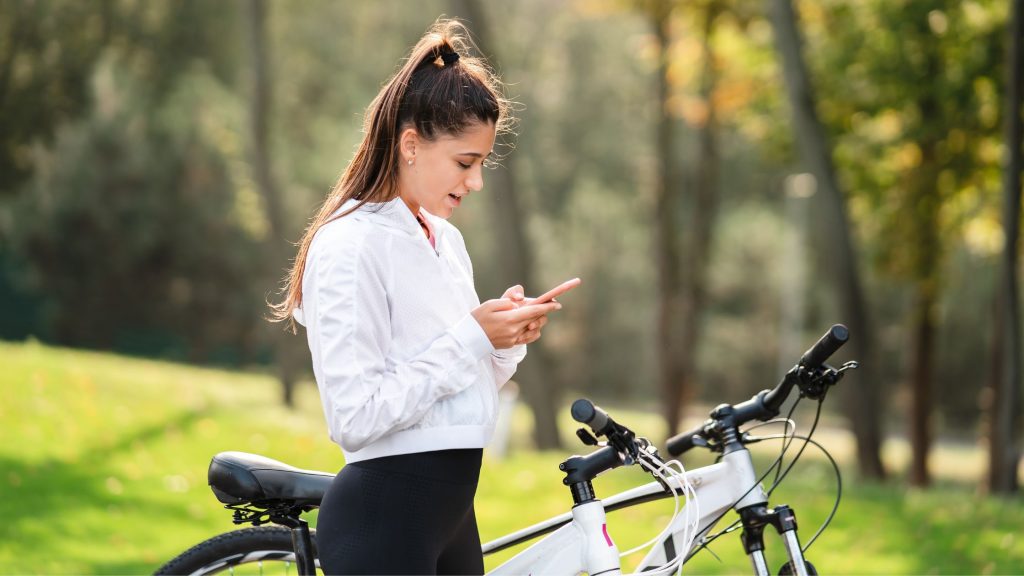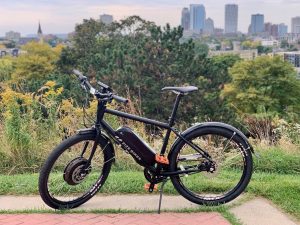Where do you put your smartphone when you ride your bike? Choosing how you store your cell phone and other belongings shows your efficiency.
Cycling becomes a hassle when you must babysit delicate technology. Many cyclists like you have come up with countless ways to carry a cell phone for convenience and safety. So, let’s examine them and see which method works best for you.
Where do you put your smartphone when you ride your bike?
Here are some ways to carry your mobile device without risking damage. Each method has its pros and cons, so you can compare them and choose the one that works for you.
Bib shorts/ Cargo shorts
Instead of having another pocket or going out with another bag, why not get another outfit with a secure pocket? Get cargo shorts with pockets.
| Pros:• No additional preparation is required | Cons:• It doesn’t look good
• Inability to allow easy access to the phone |
Bike-specific phone case
If you want to keep your phone in one place, a bike-specific phone case is a way to go. It’s also the cheapest and most practical mobile storage method for frequent cyclists. The case allows you to secure your device to your bike using Velcro, grip straps, or clips, so you can securely fasten your device to the front of your bike’s handlebars.
| Pros:• Easy to install and uninstall
• Highly customizable according to buyer preferences • Safe and economical |
Cons:• Requires buyer’s choice |
Plastic bag
Placing a simple plastic bag on the side of your bike is a cheap and easy solution to all your cell phone problems. In addition to keeping your phone close at hand, a properly tied plastic bag can also protect your phone from inclement weather. If you choose a bag that can adequately support the weight of your device, the bag should be able to protect your device from rain and snow!
| Pros:• Economical and easy to use
• It can be found around the house • Weatherability |
Cons:• Tear easily |
Quad Lock
Suppose smartphone cases are a practical option for casual riders. In that case, Quad Lock is one option for those who prefer long journeys. It’s a stretch when you think about it, as the handlebar lock mechanic requires the phone to be fused to the bike. It would help if you had a compatible phone case for that stay-on condition to occur.
| Pros:• Safe and secure
• Great for long trips and busy roads |
Cons:• Requires a suitable phone case to fit |
Armband
Armbands are an idea reinvented from running and have become part of the cycling routine! Armbands are even more useful when riding a bike because you don’t move your arms like you do when running. However, you can’t look at the screen while driving because staring at your forearm instead of the road can be uncomfortable and dangerous. If you rely on your smartphone for directions, you may want to use something other than armbands.
| Pros:• Useful for keeping the phone stationary | Cons:• It cannot be used to implement an on-screen display. |
Jersey pocket
If your cycling outfit consists of a jersey, just put your phone in your pocket! Even better if the jersey has a zipper opening, so your device stays in one place. However, if it doesn’t fit in your jersey pocket, you’ll need to secure your device in another way. Shirts are also not very effective at protecting against physical damage, so be careful if the road is bumpy!
| Pros:• Useful for keeping the phone stationary
• Zippered pocket for secure cell phone storage |
Cons:• If your phone is bigger than your pocket, it may slip out. |
Basket
Most typical bikes on the market should be able to provide a basket. If you still need to, you can always ask your warranty provider if it’s still in your plan. On the other hand, mobile phones are thrown in the trash if there is nothing in them. This method does not provide maximum security. You can’t keep your device out of the hands of thieves.
| Pros:• Comfortable and easy to grab on the road | Cons:• Mobile phones are not safe for other passengers or elements |
Bar bag
Handlebar bags are like quad locks, securing your phone to your handlebars where you need them. Unlike Quad Lock, you cannot see the screen with this tool. Keep your device away from rain and wind. Small items such as keys and IDs can also be stored!
| Pros:• Keep phones within reach of shoppers
• Protect your smartphone from rain, snow, etc. |
Cons:• Can’t see the phone screen |
Backpack
It’s sure to make you want to take your backpack on long trails. This is a natural choice for smartphones. This item is also great for protecting your device from the elements. Please note that the backpack should be kept away from sharp and hard objects to prevent damage.
| Pros:• Protect your device from rain, snow, etc.
• Protect your phone from external damage |
Cons:• Can’t see the phone screen
• The risk of your phone being damaged by objects in your backpack |
Pant pocket
Depending on what pockets your favorite pants have, you have plenty of options for storing your smartphone until your wardrobe expands. The pocket is completely attached to the body, so you don’t have to worry about the safety of your phone!
| Pros:• Keep your phone physically nearby
• Offers many choices from your closet |
Cons:• Your smartphone may slip and fall while moving |
Inner tube bag
Before cycling became a popular sport, it was popular with bicycle messengers. This option is similar to a shoulder bag or fanny pack. Still, it has a close fit and comes in various materials and designs.
| Pros:• Better protection for your phone | Cons:• You have to reach inside the bag to get it. |
Top tube bag
The Top Tube Bag combines a handlebar bag and a Quad Lock. The bag’s main function is to keep your phone visible from your handlebars. What such hybrids have about the original compartment is that the top tube bag pocket has a clear plastic sheen. This way you can keep the screen out of sight in bad weather. The top tube bag is also a stylish bicycle accessory!
| Pros:• Keep your phone safe by allowing visible windows
• Stylish and easy to install |
Cons:• It may be expensive to obtain |
Ziplock bag
Zip-Lock bags are a more classic option recommended by parents (perhaps you’ll use them yourself in the kitchen or on the go). Clip the bag to your handlebars or frame, or store it anywhere. The bag protects your phone from scratches, getting wet, and being broken.
| Pros:• Easy to find and use
• Economical and durable |
Cons:• Can slide and slide
• Provides no security |
Shoulder bag
Shoulder bags are another item similar to shoulder bags, but the models are large enough for everyday carry. Depending on how often you ride, scrolling through the selection in any store can be fun!
| Pros:• Compact and convenient
• You can carry more than just your phone |
Cons:• You have to reach inside the bag to get it. |
Frame bag
Unlike top tube bags, frame bags hang parallel to the bike frame to carry your belongings. Instead of straining your handlebars and hampering your cornering, bike frame bags don’t distract you from your ride.
| Pros:• Protect your smartphone from shaking and damage
• Can complement top tube bags |
Cons:• The whole bicycle can be heavy |
Where’s the best place to place your phone while cycling?
The trick to finding the perfect spot is to think about how you want to use your smartphone. Here’s how to try this trick.
If you want a peaceful and quiet bike ride, you can keep your phone on your back, thigh, frame, or basket. If you can’t see your device, you won’t be annoyed by notifications, calls, and reminders every two minutes. Keeping it out of reach helps you focus less on the screen and more on the scenery of your ride.
Suppose you want to track where you’re riding and your physical fitness; holding the device directly on your handlebars is the best choice. You should find a phone case way to keep your device from being exposed to the elements, but it’s worth it. If you want to answer a call or message without looking at your phone screen, wear the strap around your body so you can feel the vibration and stay alert.
After pairing your smartphone and earbuds, you can receive calls without touching the screen.
Tips and tricks
If your mobile phone is exposed (so you can see the screen), ensure other passengers can’t reach it or remove it easily. Use clips and tight straps or zip the device up to do this. It’s a good idea to enable location tracking, especially if you’re heading into the wilderness. It also sets a secure location for easy redirection.
You should bring a portable power bank and charging cable for long trips. This allows us to stay connected to civilization, even when we are away from home longer than expected.
Should I take my smartphone with me while cycling?
Yes, especially if you’re biking to an unfamiliar place. Devices aren’t a method of self-defense, so they can’t keep you safe, but they can restore communication channels to places and people you trust. Not a wise choice.
Conclusion
After all, where do you put your phone when you ride your bike? – Any of the listed options, as long as it meets your needs. Beware of all the cons too!
For more information about the bikes for any size limit, visit the Zize Bikes or contact us at [email protected].







